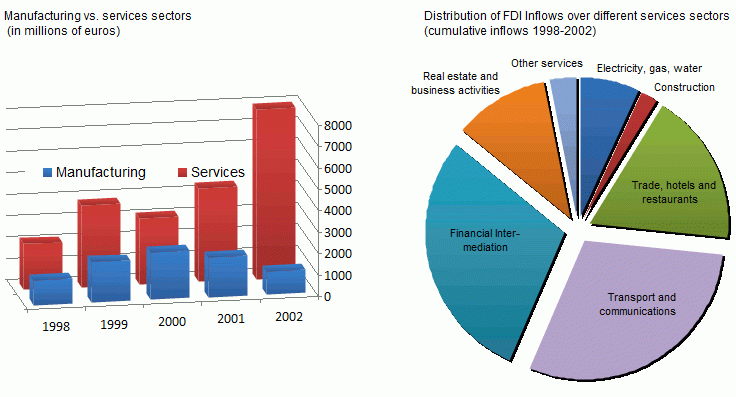Services liberalisation is a controversial subject, as is evident from recent policy debates in the EU and WTO. The scope for controversy is deep and wide. In contrast to the large body of empirical research on the impact of trade liberalisation in goods, little is known about the effects of allowing greater foreign entry in services industries. As Francois and Hoekman (2010) note, “services have not figured prominently in the economic growth and development literature, and have only recently been highlighted in the trade literature”. Since a wide range of manufacturing and services industries rely on services inputs, it seems reasonable to presume that large gains could be achieved through the liberalisation of services sectors.
In a recent paper (Arnold et al. 2011), we provide empirical evidence on the link between reforms in services sectors and the productivity of downstream manufacturing industries. Our analysis focuses on the Czech Republic, which introduced far-reaching reforms of services industries during the 1990s, including opening services sectors to foreign investors. The results, based on firm-level data for the period 1998-2003, suggest a positive association between liberalisation in services industries and the productivity of manufacturing firms using services inputs. Allowing entry of foreign services providers appears to be a key channel through which services liberalisation benefits the manufacturing sector.
Services liberalisation goes beyond eliminating barriers to international trade
Services sector reforms range from the abolition of monopolies to the elimination of barriers to entry and the privatisation of state-owned enterprises. As a result, new domestic and foreign providers are likely to enter the market and hence increase the choice of providers for downstream users of services. Greater choice of services providers may in turn affect the performance of manufacturing sectors in three ways.
- First, new services may become available through the entry of more technologically-advanced services providers. Examples include new financial instruments and cash flow management tools, multi-modal transport services, or digital value-added services in telecommunications.
- Second, the reliability of existing services may improve as a result of privatisation, competition and the entry of internationally successful players. For instance, telephone communications or electricity provision may become more reliable due to investments in infrastructure by new domestic or foreign owners, or credit decisions may be made faster as competition among banks increases.
- Third, services liberalisation may also lead to a wider availability of services that were formerly restricted to certain groups of users, such as internet coverage in rural areas or an improved availability of business consulting services to smaller firms.
The entry of foreign providers may play a particularly important role in realising these benefits. Foreign providers may bring know-how and knowledge about new products and international best practices into the country. By setting a higher standard and introducing new products, they may also put pressure on domestic suppliers to make similar improvements. Given the limited scope for cross-border trade in services inputs, we would expect the performance of downstream sectors to be tied more directly to the quality and availability of services supplied by providers operating domestically than is the case for physical intermediate inputs.
The Czech Republic: A prime example of services liberalisation
Having made substantial progress in liberalising services sectors and opening its economy to foreign direct investment (FDI), the Czech Republic is a suitable choice for our study. Within a few years of the end of the communist regime in 1989, the government of the former Czechoslovakia privatised many state-owned enterprises, liberalised prices and wage-setting, and began to open the country to foreign trade and FDI. In 1998, Czech policymakers adopted an even more welcoming approach to FDI, particularly in services industries, and FDI inflows saw a steep rise. From then on, a majority of FDI inflows into the Czech Republic have been directed into services rather than manufacturing sectors, and almost all services industries have attracted foreign investors (Figure 1).
Figure 1. FDI Inflows into the Czech Republic 1998-2002
Source: Czech National Bank
The progress of the liberalisation of the Czech economy with respect to both domestic regulation and openness to foreign entry was closely monitored by the EU in preparation for the country’s accession in 2004. The fact that substantial liberalisation of services was required to attain one of the country’s major policy goals lends considerable exogeneity to the pace of reform and suggests that services liberalisation and openness to foreign entry were externally determined rather than a response to domestic lobbying.
We use four different measures to quantify services liberalisation:
- an index of policy reforms created by the European Bank for Reconstruction and Development (EBRD), taking into account all aspects of services liberalisation, including both the domestic and the international dimension;
- the share of services output provided by foreign-owned firms;
- the share of services provided by private and privatised firms; and
- the extent of competition in services sectors.
Liberalisation benefits are visible in services sectors…
There is considerable anecdotal evidence (cited in the study) on how liberalisation, and particularly the presence of foreign providers, improved Czech services. Moreover, the results of a World Bank survey of 350 Czech firms in 2004 indicate that Czech entrepreneurs had a favourable view of foreign services providers. Finally, our own analysis combining the difference-in-differences approach with propensity score matching shows that foreign acquisition of Czech services firms increased the volume of sales and boosted labour productivity in the acquired firms. This result is consistent with the idea of foreign services providers bringing new technologies and know-how to the Czech Republic and providing services with greater appeal to Czech consumers.
… and beyond
To examine the link between services sector reforms and the performance of services users, we relate the total factor productivity of manufacturing firms to the state of liberalisation in services sectors weighted by the respective manufacturing sector’s reliance on inputs from each services sector. Our identifying assumption is that the effect of services reform should be more pronounced in manufacturing sectors relying more heavily on services inputs. We control for the availability of material inputs provided by foreign-owned companies operating in upstream manufacturing sectors, for tariffs on imported intermediate inputs, and for foreign presence and tariff protection in the same sector. We also include firm-fixed effects to control for unobserved firm heterogeneity and capture time-invariant effects specific to the industry and the region in which a firm operates.
Two conclusions
Our results suggest two conclusions.
- First, we find that services policy matters for manufacturing performance, as manifested in the strong link between services sector reform and the productivity of local producers relying on services as intermediate inputs. This finding is robust to several different econometric specifications, including controlling for a number of other possible influences.
- Second, we find evidence suggesting that opening services sectors to foreign providers is a crucial channel through which services reforms affect downstream productivity in manufacturing. This finding is robust to instrumenting for the extent of foreign presence in services industries.
Today, most of the barriers limiting FDI flows are not in goods but in services, reflecting the unwillingness of governments to allow unrestricted foreign presence in what they believe are “strategic” sectors. Our analysis, as well as similar findings from Chile (Fernandes and Paunov, forthcoming) and India (Arnold et al. 2010), suggest that these restrictions on a foreign presence in producer services can seriously dampen the growth of productivity in manufacturing industries.
References
Arnold, Jens, Beata Javorcik, Molly Lipscomb, and Aaditya Mattoo (2010), “Services Reform and Manufacturing Performance: Evidence from India”, CEPR Discussion Paper 8011.
Arnold, Jens, Beata Javorcik, and Aaditya Mattoo (2011), “Does Services Liberalization Benefit Manufacturing Firms? Evidence from the Czech Republic”, Journal of International Economics, 85(1).
Fernandes, Ana M and Caroline Paunov (forthcoming). “Foreign Direct Investment in Services and Manufacturing Productivity: Evidence for Chile”, forthcoming in the Journal of Development Economics.
Francois, Joseph and Bernard Hoekman (2010), "Services Trade and Policy", Journal of Economic Literature, 48(3).





